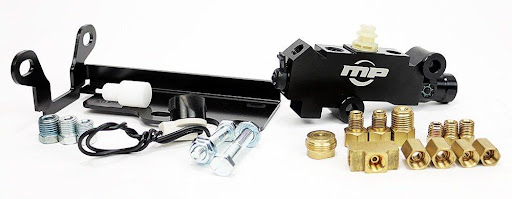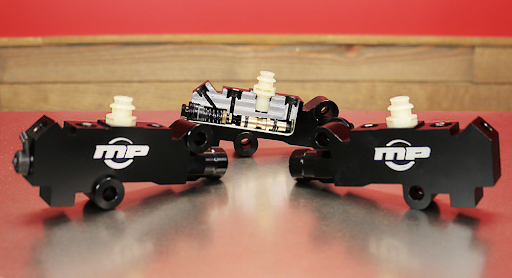
You’ve got 4 main options when it comes to brake valves. And while not all brake valves are necessary, all are possible options for maximizing the efficiency of your braking system. Our tech experts walk you through each of the different types of brake valves and help you determine which ones you need to get the most function and enjoyment out of your ride.
- Combination Valve
- Adjustable Proportioning Valve
- Metering Valve
- Residual Valve (2 lbs. and 10 lbs.)
1. Combination Valve
A combination valve is sometimes referred to as a proportioning valve, and while a combination valve contains a proportioning valve, that’s an incomplete picture of the true function of this valve.
Master Power Brakes Combination Valve Kit
The combination valve has three main components:
Proportioning Valve
The proportioning valve affects the rear brakes and is called upon in a heavy braking scenario. When you have to brake hard or jam on the brakes, the proportioning valve kicks in and limits pressure to the rear brakes, preventing lock up and spin out.
Metering Valve
Combination valves are available for both disc-disc and disc-drum brake systems.
The disc-drum version contains a metering valve that functions to hold offline pressure on the front brakes until the rear brakes kick in. This is important to prevent nose dives.
RELATED: Disc-Disc vs. Disc-Drum Brakes: What’s the Difference?
Pressure Differential Switch
Combination valves also have a pressure differential switch. This valve works in the case of a loss of pressure to either the front or rear brakes. The valve/switch kicks in and blocks off pressure to that line, reserving pressure to either the front or rear brakes, allowing you to maintain one or the other so that you can safely come to a stop.
Where Should I Mount My Combination Valve?
In most cases, the easiest place to mount your combination valve is under the master cylinder, or anywhere near and slightly below it. This location makes it easy to make all the connections between the valve and the master cylinder, and below level helps keep the fluid in the lines running freely.

2. Adjustable Proportioning Valve
The adjustable proportioning valve is a great option if you’re looking for a little more control over what your brakes will do. This valve is used by itself in a disc-disc brake setup, or in conjunction with a metering valve in a disc-drum brake setup.
This valve is responsible for controlling line pressure to the rear brakes only. A knob/dial allows you to increase or decrease pressure to your ideal level.
RELATED: Engine Performance Testing with a Vacuum Gauge
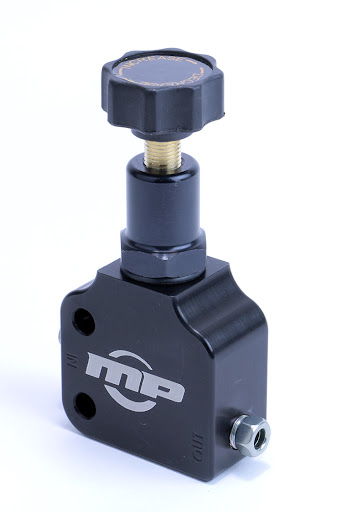
An adjustable proportioning valve is used to adjust rear brake pressure in either a disc-disc or a disc-drum setup.
3. Metering Valve
A metering valve is used in a disc-drum brake setup and is installed on the front brakes. The metering valve is responsible for holding off pressure to the front disc brakes in order to allow the rear drum brakes to catch up, helping to prevent nosedives.
RELATED: Why Does My Car Nosedive When Braking?
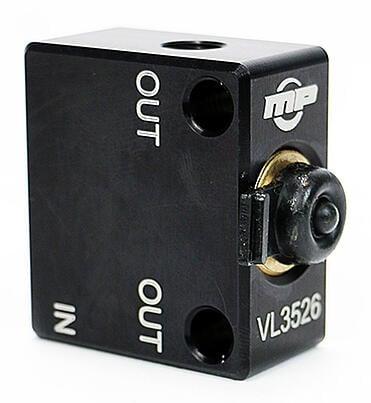
4. Residual Valve
A residual valve can be used for both the front and rear brakes. Residual valves come in two sizes – 2 lbs. and 10 lbs. – with each applying to disc and drum brakes, respectively. 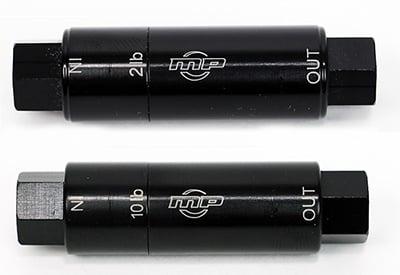
Residual brake valves in two sizes: 2 lbs. for disc brakes and 10 lbs. for drum brakes
A residual valve is a great option when your master cylinder is mounted below your car. In this type of setup, it’s common for brake fluid to backflow into the master cylinder, which can result in a soft brake pedal. A residual valve prevents that from happening.
UP NEXT:
Why is My Brake Pedal Soft? How to Diagnose and Fix
How to Test Your Brakes BEFORE Hitting the Road
My Classic Car Has Manual Brakes. Can I Add a Power Brake Booster?
Are you looking for a new valve for your brake system or have questions about your brakes in general? Your classic car deserves better than salvage yard brake parts or the original components included with your ride, and we are here to help.
- Technical assistance
- Pricing information
- Placing an order

